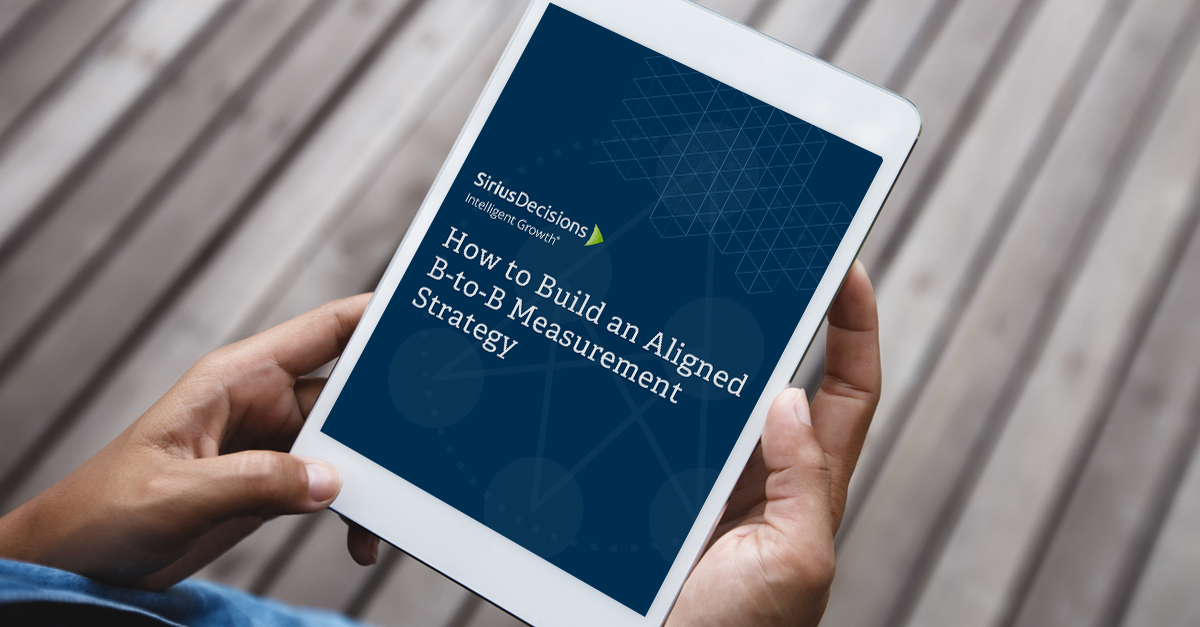Great B2B Marketing Measurement Doesn’t Happen by Accident
- B2B marketing leaders rely on a solid system of measurement to drive better decision-making
- Great measurement must be developed to answer key business questions for a properly understood audience of stakeholders
- By following a well-defined process, organizations can achieve aligned measurement that drives better performance
B2B marketing is well past the point where leaders question the importance of solid marketing measurement. Great measurement allows marketing leaders to use a strong understanding of the past and present to confidently make decisions about what do in the future. Yet an overwhelming majority of marketing leaders I speak with are not comfortable with the measurement they have. If measurement is so important, why do so many marketing organizations continue to struggle to get what they need?
 Expectations are often the problem here. Contrary to popular belief, great marketing measurement never just comes together on its own. In my research, I focus on what it takes to build great measurement and what typically gets in the way. If you’re serious about improving your company’s marketing measurement, here are a few of the most important things you need to know:
Expectations are often the problem here. Contrary to popular belief, great marketing measurement never just comes together on its own. In my research, I focus on what it takes to build great measurement and what typically gets in the way. If you’re serious about improving your company’s marketing measurement, here are a few of the most important things you need to know:
- Effective measurement is customized. Marketing measurement must help organizations understand how marketing is contributing to business objectives, what’s working and what needs to improve. But there’s a tremendous amount of variation between what marketing organizations may be working to accomplish. Some prioritize finding more leads, while others concentrate on generating more business with strategic accounts, and others still look to soften the ground for productive sales conversations through brand building. And they do all these things in slightly different ways, emphasizing different strategies, approaches and tactics. To be meaningful, B2B marketing measurement must be aligned to the specific ways that marketing is intending to create value.
- Different marketers have different measurement needs. If all marketers were responsible for making the same decisions, they could all use the same reporting. But marketing work is typically highly distributed, and different users need different types of information to make the decisions necessitated by their work. An executive needs a different level of detail than a campaign specialist, for example. We can’t continue to give everyone the same information and hope they’ll learn to sift through it to find the data they need to do their jobs.
- Different metrics address different business questions. Ultimately, measurement needs to be used to answer business questions. How much did we spend? How does lead volume compare to what we need? Is our awareness among a key audience improving? Different types of information may also be required to support different types of meetings (e.g. quarterly business reviews vs. weekly campaign updates). Organizations that can identify the questions that need to be answered – and the meetings in which they need to be answered – do a better job in developing the metrics that matter.
- More reporting is not necessarily better. At some organizations, measurement-related questions just seem to multiply and never get prioritized. As reporting teams struggle to keep up with never-ending requests, a more fundamental concern is that users can’t absorb this information. Having too many choices confuses users and splits their attention, while fostering greater misalignment as everyone picks and chooses their favorite set of metrics.
- Self-service alone isn’t the answer. Faced with the prospect of not being able to handle endless requests for reporting, some organizations turn to a self-service model – simply putting all the data out there and hoping for the best. Investing in a common data platform can represent a partial solution, but it’s not enough. Although some users can self-serve some of their measurement needs, our research shows that most marketing users don’t have the skill or time to effectively generate their own reporting. Self-service works best in a highly curated reporting environment, where the measurement team has provided the focus on metrics that matter for defined use cases.
- Measurement must be used to create value. Measurement that isn’t used doesn’t improve decision-making. However, most marketing organizations don’t understand how much their measurement gets used or how well it answers key questions. Best-in-class measurement organizations plan to drive utilization of their measurement and monitor its ongoing effectiveness. That’s a much better use of resources than continuously building yet another report.
B2B marketers currently have more access to performance data than ever before. The challenge is turning all that data into intelligence that gets used to drive better decisions. Building great measurement is possible. Through our research, we’ve defined a best-in-class approach for building aligned measurement. See our e-book on Building an Aligned Measurement Strategy to learn more.
